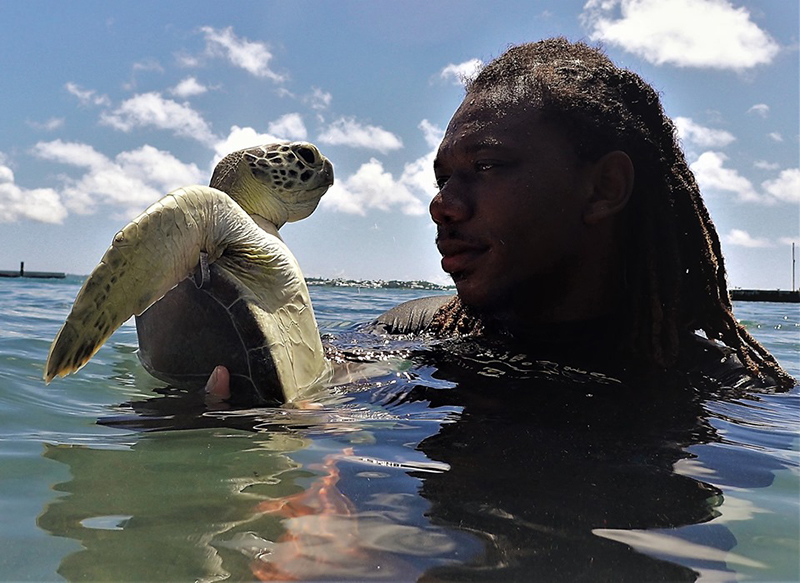Turtle Project’s 2019 Field Trip Underway
The Bermuda Turtle Project, one of the oldest ecological studies of its kind on the island, is this summer beginning its second half-century of research and conservation initiatives aimed at protecting our sea turtles.
Established in 1968 by the Bermuda Aquarium, Museum & Zoo in collaboration with the Florida-based, environment-friendly Sea Turtle Conservancy international charity, the Bermuda Turtle Project’s research is focussed on filling in gaps in researchers’ knowledge about green turtle biology to afford better protection to the endangered sea creatures.
“Hard to believe we are more than half-way through the 2019 field season,” the Bermuda Turtle Project announced this week [Aug 18] on its social media feeds. “Our team is amazing, the learning extraordinary, the work hard but the rewards great.
“Once the session is over we will update you with findings but for now enjoy a snapshot of our students out on the water in pursuit of sea turtle research, education and conservation.”
Every summer Bermuda Turtle Project team members and volunteers spend about 20 days visiting green turtle feeding grounds, sea grass beds which are nestled between the ledge flat reefs on the northern side of Bermuda.
“Once the study site of the day is reached, the large research vessel is anchored on the outer edge of the reef,” says the Turtle Project. “The smaller catch boat, towing a net boat and entrapment net, is loaded with team members.
“The catch boat moves inside the reef. Sea turtles have an acute sense of hearing and are easily chased off by engine noise and other unusual sounds, so the approach to the site is made as quietly as possible.”
The team then deploy an entrapment net 2,000 feet long and 20 feet deep, and snorkellers remove entangled turtles and take them to the work boat as quickly as possible.
“Our average catch for one set of the entrapment net is between five and six animals; our record catch for a single set of the net is 46 turtles,” says the Turtle Project. The work boat with turtles and crew returns to the research vessel to which turtles are transferred for data collection. This includes tagging or re-tagging, measuring, weighing and collection of blood and tissue samples.
“During the data collection process, the turtles are lined up on the deck. Swim noodles, bent and strapped together, provide each turtle with a bed. Volunteers keep the turtles doused with cool salt water.
“Each of the turtles is triple-tagged with a combination of external plastic and metal tags, plus an internal PIT tag, a small radio transponder that contains a specific code, which allows individual turtle to be tracked. External tags have an address and a reward message. About one-quarter of the turtles captured have been previously tagged by us and frequently, the old tags must be changed to a larger size.”
Each turtle is carefully weighed and measured. Growth rates from recaptured tagged turtles help the Bermuda Turtle Project to refine estimates of age at sexual maturity and help to determine the length of residency in Bermuda. Information on age at sexual maturity is critical for population models.
Blood samples taken from each turtle are used to determine the sex of the individual turtle and the genetic identity. Determination of sex ratios is important for understanding population structure.
“At the end of a day’s sampling, it is always a favourite task of our volunteers to release each turtle back onto the site,” says the Turtle Project.
Since 1968, the use of the entrapment netting method has resulted in more than 3,100 turtle captures.
Photos courtesy of the Bermuda Turtle Project
Read More About
Category: All, Environment





I think they are going to be getting hungry soon – they have pretty much eaten all the turtle grass on most of the shallow flats around the Island.